Burma-Shave Highway Signs ~ The History of Ordinary Things

Do you recall the series of 6 red Burma-Shave advertising signs along the country highways?
In 1925, Clinton Odell and his brother, Allan, installed these sequential road signs to market Burma-Shave, a brushless shaving cream. In the early 1920s, their father had started the Burma Vita Co. to sell a liniment for pain. It was unsuccessful. He then enlisted a chemist, Carl Noren, to create a brushless shaving cream. The 143rd formula, when aged, resulted in a stable cream that supplied a fine shave. He called it Burma-Shave.
Selling a brushless shaving cream in the early 1900s required men to give up their shaving brush and shaving mug, a time-honored barbering tradition. Burma-Shave touted convenience, especially when traveling. Men didn’t have to pack a wet brush that would mildew and smell. Brushless cream was faster to use and modern.
Allan proposed a set of signs to promote Burma-Shave. With $200, he bought used boards, sawed them into 36-inch lengths and painted them red with 4” white Gothic letters. A 5-sign jingle was followed with Burma-Shave on the 6th sign. Set 100 paces apart, they were designed to be read at 35 mph, the cruising speed in the 1920s. The first sets were put on U.S. Hwy 65 from Minneapolis to Albert Lea, MN and U.S. Hwy 61 from Minneapolis to Red Wing, MN. Orders from the drivers on these roads started coming in.
The jingles used a mix of folk humor and wit, wordplay and pun, slang and colloquialism. The corny humor was much needed in the post-depression era. The public associated the comfortable style with friendly business folks. Initially written by Clinton and Allan, by the 1930s, the jingles were selected from annual contest entries paying $100 for selected jingles.
HIS FACE WAS SMOOTH / AND COOL AS ICE / AND OH LOUISE! / HE SMELLED / SO NICE / BURMA-SHAVE (1935)
Burma-Shave used flirty-but-clean sex themes with many boy-girl jingles.
HE HAD THE RING / HE HAD THE FLAT / BUT SHE FELT HIS CHIN / AND THAT / WAS THAT / BURMA-SHAVE (1934)
IF YOU THINK / SHE LIKES / YOUR BRISTLES / WALK BARE-FOOTED / THROUGH SOME THISTLES / BURMA-SHAVE (1935)
Other themes were public and highway safety and preventing forest fires. Often the theme admonished one to avoid substitute brands.
GIVE THE GUY / THE TOE OF YOUR BOOT / WHO TRIES / TO HAND YOU / A SUBSTITUTE / BURMA-SHAVE (1932)
Burma-Shave signs expanded across MN, Iowa and Wisconsin in 1926. Ultimately, over 7,000 sets were posted across 44 states. Only four states were WITHOUT official signs. Arizona, Nevada, and New Mexico because they did not have enough traffic. Massachusetts roads too twisty with heavy foliage that blocked the view of the series. (Alaska and Hawaii became states in 1959.)
DOES YOUR HUSBAND / MISBEHAVE / GRUNT AND GRUMBLE / RANT AND RAVE / SHOOT THE BRUTE SOME / BURMA-SHAVE (1930)
At their peak, Burma-Shave was the 2nd highest selling brushless shaving cream in America. The road signs had worked in the 1930-1950s, perhaps because of the light-hearted and often corny, humor. It was a novel and captivating approach to advertising.
By the late ‘40s, the heyday of Burma-Shave signs was over. What happened? Certainly, highways and interstate roads diverted the traffic patterns with fewer folks driving the country roads. But ultimately, TV reached more people and could quickly tell the story of your product. The corny signs could not compete.
Burma Vita Co. explored print, radio, and TV marketing, but announced a sale to Philip Morris, Inc. in 1963. It became a division of American Safety Razor Products who shifted marketing dollars to television. Manufacturing and the classic signs ended in 1966. (In the 1990s, the nostalgic Burma-Shave brand was reintroduced with a line of shaving cream, razors, and accessories.)
The Burma-Shave signs impacted whole generations of country-drivers. What are your memories?
Excerpt from “The Verse by The Side of the Road – The Story of the Burma Shave Signs and Jingles”, by Frank Rowsome, Jr. Printed 1965-1972
- Keeping Things Level Over Time ~ The History of Ordinary Things - March 15, 2024
- A Brief On Lingerie ~ The History of Ordinary Things - February 16, 2024
- Hand Shaping Ice Until The Zamboni ~ The History of Ordinary Things - January 19, 2024


